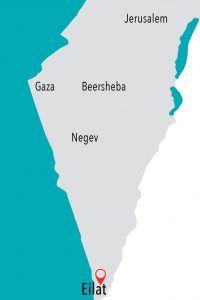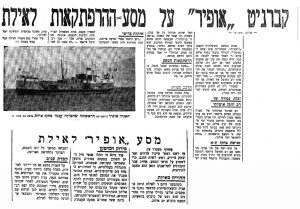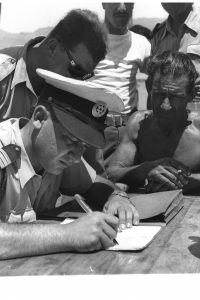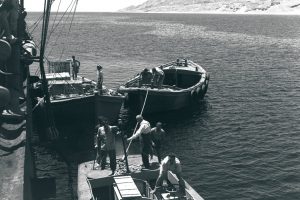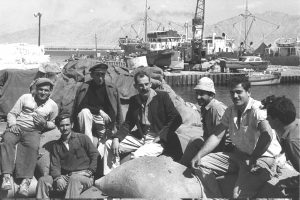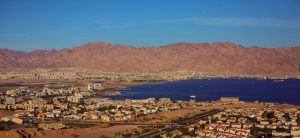Red Sea Port
Traversing the rickety road from the Israeli port of Eilat to its Egyptian equivalent in Taba, past thousands of imported cars lined up in spectacular order, glinting in Eilat’s glaring sun, it’s hard not to feel a glimmer of pride. Somehow this pinch-waisted country, less than ninety kilometers across from Ein Gedi to Ashkelon, has become a maritime player in the Middle East. Nowhere else in the region offers a shore-to-shore experience that includes a dip in the freshwater Sea of Galilee, sailing on the Mediterranean, Dead Sea mud baths, and snorkeling in Eilat’s clear blue sea. No wonder the neighbors are a touch envious.
Egypt was incensed by Israel’s conquest of Eilat (then called Umm Rash Rash) in the War of Independence, and by the new state’s insistence on keeping the port. After Nasser came to power, he closed the Straits of Tiran to Israeli shipping in 1956, bringing about the disastrous (for Egypt) Sinai Campaign. He tried again in 1967, resulting in the Six-Day War, in which Egypt lost the entire Sinai Peninsula.
Israelis like Eilat, and we prefer it open to international trade, with the Egyptian army at a safe distance.
Gateway to the Far East
Though Eilat offers numerous tourist attractions, its port is its pride. The website of the government-owned Eilat Port Company boasts that it’s the “closest major port to the Far East.” But before you start dreaming of sushi and cherry blossoms, click on the website’s history page. There you’ll learn that by the early 1950s, ships were already sailing gaily toward Eilat’s shores, only to discover its complete lack of docking facilities. Freighters had to unload their cargo onto small boats in mid-ocean, until in 1955 work began on the first Eilat Port – now known as the “Old Port.” In 1965 it was replaced by the “New Port,” still used today.
Unfortunately, this overview makes no mention of the drama preceding the docking of the port’s very first ship, in 1950. Nor do these events appear on the Eilat municipal website, which also has a history section. The only online hint of this fantastic voyage lies in an upload of a quiz booklet produced by the municipality in honor of – for some reason – the town’s fifty-ninth anniversary, in 2006.
In July 1950, Israeli headlines breathlessly announced the arrival down south of an Italian ship, the Lucia, straight from the Yemenite beaches of Aden. Actually, the vessel was called the Luce, and it was renamed the Ofir upon docking in Eilat. In any case, it carried thousands of Jewish books – including hundreds of Torah scrolls – preserved for generations in the synagogues of Yemen. When the country’s Jews flew to Israel in Operation Magic Carpet that year, they weren’t about to leave their entire written heritage behind. But how did it end up on an Italian ship?
Rough Waters
The Al Ha-mishmar daily reported:
This treasure gradually mounted in the American Jewish Joint Distribution Committee’s transit camp in Aden. Transfer was arranged by sea, and a ship hired to sail to Eilat on Wednesday. Each group of Yemenite immigrants arriving at the camp from another far-flung corner of Yemen brought with it, in addition to personal effects, Torah scrolls and manuscripts from synagogues that had closed up shop. There was no way this wealth of scrolls and books could be sent to Israel “on eagles’ wings,” as the heavy load would have taken up space reserved for people. (“Ship with Cargo from Aden Arrives in Eilat,” Al Ha-mishmar, June 25, 1950 [10 Tammuz 5710], p. 1)
It sounds perfectly straight-forward – cargo sent by sea instead of by air – but it wasn’t. Israel’s Red Sea territorial rights had yet to be defined, and British patrol boats still ruled the waves off Eilat’s coast. As a result, the Yemenites’ precious heritage had to run a gauntlet of unfriendly sea passages, requiring extra precautions. That’s why the ship hired for this purpose was Italian, and too run-down to attract attention. An agent from the Joint, Mordecai Lapidot, was planted among the boat’s African sailors to watch out for trouble and keep an eye on the ship’s Italian captain, Chiaso, who was drunk most of the voyage.
Sailing directly from Aden to Eilat generally took about ten days, but the Luce was posing as an ordinary cargo ship, so it docked patiently at several commercial ports along the way. When it failed to show up in Eilat two and a half weeks after departure, the impatient few in on the secret – Eilat mayor Avraham Zakai; Isaiah Sharabi, Yemenite Jewry’s representative in Israel and later in the Knesset; and a small group of journalists – were beside themselves. Frantic inquiries revealed that the ship had been held up by a sudden storm in the Red Sea. Next day, there was still no sign of the Luce, this time thanks to engine trouble. A day later the craft ran out of diesel, and a supply boat had to be dispatched. The engine broke down time after time, and then disaster was only narrowly averted when the outdated ship ran aground on a shoal. Maariv quoted Captain Chiaso’s account of what happened next:
The climax of a long, tense journey came as we approached the Gulf of Aqaba. The British destroyer anchored at Aqaba signaled us to approach, but … we ignored the signals. Shrugging our shoulders, we headed straight for Eilat. (“Ofir’s Skipper on His Adventure-Filled Voyage to Eilat,” Maariv, June 25, 1950 [10 Tammuz 5710], p. 1)
New Conquest
For forty days and forty nights, like something out of the Bible, the Luce tossed on the Red Sea, eventually docking safely in Eilat. Excited Maariv reporters turned up two days later (Eilat was over a day’s car trip from Tel Aviv):
When we arrived on Friday, the ship was the main topic of conversation on the stunning beach. Eilat’s pioneers and soldiers were seized with the thrill of a new conquest, this time the Gulf of Eilat. (ibid., p. 4)
But if you think this tale continues with seasoned stevedores, forklifts, and cranes, think again. The manuscripts and Torah scrolls were unloaded haphazardly at sea, with the ship’s African crew and Israeli naval cadets trying vainly to coordinate.
Dr. Azriel Carlebach, legendary founder of Maariv, was there too, emotionally comparing the Ofir’s arrival to the docking of the Mayflower at Plymouth Rock:
Let’s photograph him well, this Italian captain, Mr. Chiaso, who brought the Ofir from Aden to Eilat, and likewise the figures of these anonymous negroes, now unloading their cargo onto the sands of Etzion Geber [the biblical name for Eilat]…. They neither know nor appreciate it, but one day books will be written that start with them, the miserable black stevedores who earned three shillings a day for making history….
History will then fast-forward to far more glamorous, brave chapters … to the growth of this wonder-state, which suddenly established itself on Asia’s doorstep and extended its tentacles to the far reaches of the Red Sea … the shockwaves that passed through all the neighboring countries as they witnessed this wonderful vision – an impulsive nation that had reached Eilat just a year before and was already trying to stretch out and embrace the world. (Maariv, June 26, 1950, p. 4)
Baggage Claim
With Eilat Port open, Carlebach gushed that “Israel stands at the crossroads of the world” (ibid.). But no books have documented the opening of the port, and the black sailors of the Ofir are still anonymous. Even the Internet says nothing about these unsung heroes.
More disturbing, however, is the fate of the priceless cargo. Israeli historian Dr. Mordecai Naor investigated the matter:
The end of the story is somewhat murky. The Yemenite immigrants’ luggage and Torah scrolls remained in Eilat for a while, perhaps even a long while. A few reports in the papers of July 1950 stated that the crates were falling apart, with all the inevitable consequences for their contents. The whole load was then transferred to Jaffa Port, where the various owners were invited [to claim their stuff]. When dozens and hundreds of Yemenite immigrants arrived, their faces fell: crates had disintegrated, packages were rolling on the ground, and almost all identifying features had been rubbed out or faded away. There were allegations that some of the cargo had been lost or stolen, including Torah scrolls and valuable Judaica. (Mordecai Naor, More Stories of the Land I Love [1994], p. 199 [Hebrew])
What Became of the Ofir’s Cargo?
Investigative journalism undertaken by Israel’s Channel Ten in February 2003 depicted the events of June 1950 more grimly. Apparently, the Yemenites’ manuscripts and silver Judaica – including Torah crowns and cases – were unloaded in Eilat but never made it to the warehouse in Jaffa. They were stolen and sold well before that. The “unfortunate fire” that broke out in the storage facility in 1951 before the immigrants’ very eyes, destroying all its contents, was – according to the report – literally a smoke screen.
The exposé produced an uproar, leading Knesset member Yehiel Hazan to call for a parliamentary commission of inquiry. Hazan claimed:
Existing reports raise suspicions that the immigrants’ possessions, which included rare manuscripts, were collected on Jewish Agency orders in crates that were to be sent to Eilat; and that certain parties were particularly interested in purchasing these valuable items for research institutes and so forth…. We must determine … what exactly happened. Were false representations intentionally made to the immigrants due to outside interests? Were official bodies involved? Did the Yemenites receive any appropriate compensation? (Yehiel Hazan to Knesset chairman, March 23, 2003, Knesset archives)
In the 1950s, Eilat was a small, isolated frontier settlement on Israel’s southernmost tip, developing into a town only in the 1960s. After the peace accords with Egypt, it was once again Israel’s only outlet to the Red Sea, and hotel tourism followed apace. Eilat in 2012
The mystery was never solved. The dilapidated Luce/Ofir sailed back out to sea, leaving Eilat behind without ringing up a single duty-free purchase. The port moved further up the coast to deeper waters in 1960, making room for vacationing Israelis to work on their suntans. With new airport facilities and a railroad well under way, Eilat promises to put Israel on the map as an international hub. That’s quite something when you remember how it all started.

